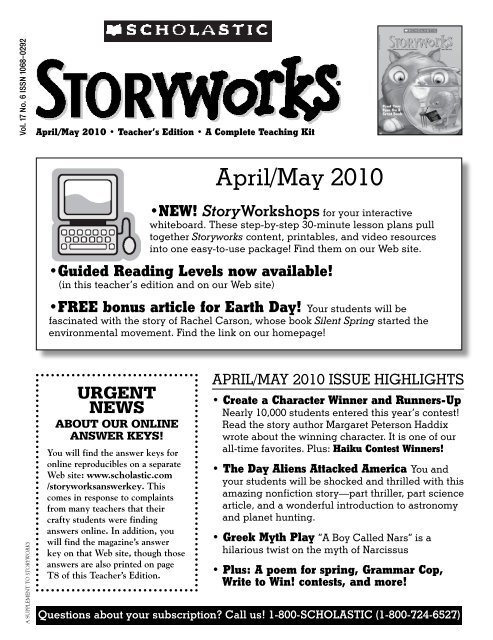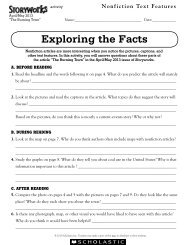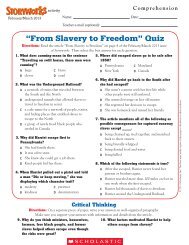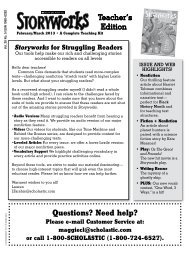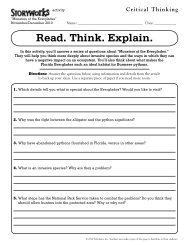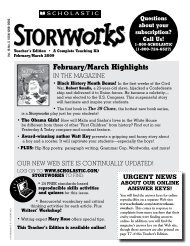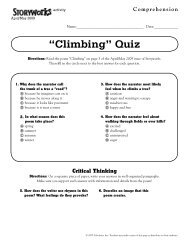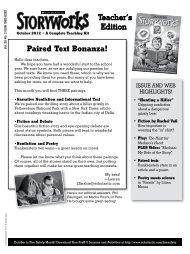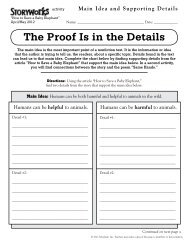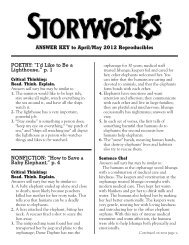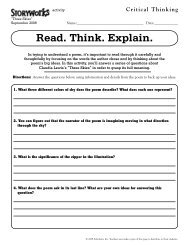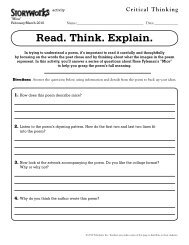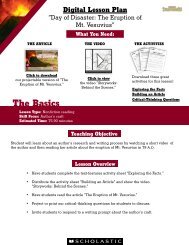april/may 2010 - Storyworks Magazine - Scholastic
april/may 2010 - Storyworks Magazine - Scholastic
april/may 2010 - Storyworks Magazine - Scholastic
Create successful ePaper yourself
Turn your PDF publications into a flip-book with our unique Google optimized e-Paper software.
Vol. 17 No. 6 ISSN 1068-0292<br />
A SUPPLEMENT TO STORYWORKS<br />
April/May <strong>2010</strong> • Teacher’s Edition • A Complete Teaching Kit<br />
URGENT<br />
NEWS<br />
ABOUT OUR ONLINE<br />
ANSWER KEYS!<br />
You will find the answer keys for<br />
online reproducibles on a separate<br />
Web site: www.scholastic.com<br />
/storyworksanswerkey. This<br />
comes in response to complaints<br />
from many teachers that their<br />
crafty students were finding<br />
answers online. In addition, you<br />
will find the magazine’s answer<br />
key on that Web site, though those<br />
answers are also printed on page<br />
T8 of this Teacher’s Edition.<br />
<strong>april</strong>/<strong>may</strong> <strong>2010</strong><br />
•NEW! StoryWorkshops for your interactive<br />
whiteboard. these step-by-step 30-minute lesson plans pull<br />
together <strong>Storyworks</strong> content, printables, and video resources<br />
into one easy-to-use package! Find them on our Web site.<br />
•Guided Reading Levels now available!<br />
(in this teacher’s edition and on our Web site)<br />
•FREE bonus article for Earth Day! your students will be<br />
fascinated with the story of rachel Carson, whose book Silent Spring started the<br />
environmental movement. Find the link on our homepage!<br />
<strong>april</strong>/<strong>may</strong> <strong>2010</strong> issuE highlights<br />
• Create a Character Winner and Runners-Up<br />
Nearly 10,000 students entered this year’s contest!<br />
read the story author margaret peterson haddix<br />
wrote about the winning character. it is one of our<br />
all-time favorites. plus: Haiku Contest Winners!<br />
• The Day Aliens Attacked America you and<br />
your students will be shocked and thrilled with this<br />
amazing nonfiction story— part thriller, part science<br />
article, and a wonderful introduction to astronomy<br />
and planet hunting.<br />
• Greek Myth Play ”a Boy Called Nars” is a<br />
hilarious twist on the myth of Narcissus<br />
• Plus: A poem for spring, Grammar Cop,<br />
Write to Win! contests, and more!<br />
Questions about your subscription? Call us! 1-800-SCHOLASTIC (1-800-724-6527)
Major Features<br />
Poetry, p. 3<br />
“There’s Something on<br />
Skreber”<br />
By Ja c k Pr e l u t s k y<br />
Fiction, p. 8<br />
Create a Character Contest:<br />
“The Treasure Hunt”<br />
By Ma r g a r e t Peterson<br />
Ha d d i x<br />
Lexile Level 680L<br />
Guided Reading Lev. R<br />
Nonfiction, p. 18<br />
“The Day Aliens Attacked<br />
America”<br />
Lexile Level 900L<br />
Writing Activity:<br />
Sentence Chef:<br />
Paragraph-writing activity<br />
Play, p. 24<br />
A Boy Named Nars<br />
By sa r i Bo d i a n d<br />
la u r a toffler-co r r i e<br />
Lexile Level 360L<br />
Guided Reading Lev. T<br />
Poetry, p. 32<br />
“The Secret Song”<br />
By Ma r g a r e t Wise Br o W n<br />
Departments and Skills Pages<br />
T2<br />
Crossword Puzzle<br />
Vocabulary<br />
page 4<br />
Sentence Chef<br />
Paragraph Writing<br />
page 23<br />
S T O R Y W O R K S<br />
April/May at a Glance<br />
Language Arts Standards<br />
and Skills Development Web Reproducibles<br />
Primary Standards and Skills:<br />
•Understanding<br />
figurative language<br />
•Vocabulary/Word<br />
study<br />
•Comprehension<br />
Quiz<br />
•Text-to-self<br />
•Critical<br />
Thinking Questions<br />
Other Standards and Skills: reading<br />
comprehension, critical thinking, writing to prompts<br />
Primary Standards and Skills:<br />
•Understanding<br />
setting<br />
•Understanding<br />
plot<br />
•Identifying<br />
cause and effect<br />
Other Standards and Skills: examining story<br />
structure, identifying supporting details, understanding<br />
character, vocabulary, understanding character’s<br />
motivation, critical thinking, identifying plot<br />
elements, writing to prompts<br />
Primary Standards and Skills:<br />
•Reading<br />
for information<br />
•Understanding<br />
details<br />
•Critical<br />
thinking<br />
•Cause<br />
and effect<br />
Other Standards and Skills: understanding<br />
terms/vocabulary, comparing and contrasting, drawing<br />
conclusions, conducting research, writing to prompts<br />
Primary Standards and Skills:<br />
•Understanding<br />
character<br />
•Understanding<br />
plot<br />
•Understanding<br />
genre<br />
Other Standards and Skills: identifying<br />
details, making inferences, understanding character’s<br />
motivation, understanding cause and effect, writing to<br />
prompts<br />
Primary Standards and Skills:<br />
•Understanding<br />
repetition in poetry<br />
•Identifying<br />
topic<br />
•Comparing<br />
and contrasting<br />
•Making<br />
inferences<br />
Other Standards and Skills: illustrating the<br />
poem<br />
Grammar Cop<br />
Possessives<br />
page 5<br />
Word Power<br />
Vocabulary<br />
page 30<br />
Writing Rescue!<br />
Run-on Sentences<br />
page 7<br />
•Using<br />
Exaggeration in Poetry<br />
•Comprehension<br />
Quiz<br />
•Critical<br />
Thinking Questions<br />
•Vocabulary<br />
•Cause/Effect<br />
•How<br />
Setting Affects Character<br />
•Comprehension<br />
Quiz<br />
•Critical<br />
Thinking Questions<br />
•Vocabulary<br />
•Creative<br />
Thinking/<br />
Conducting an Interview<br />
•Research/Sequencing<br />
•Comprehension<br />
Quiz<br />
•Critical<br />
Thinking Questions<br />
•Vocabulary<br />
•Understanding<br />
Genre<br />
•Comprehension<br />
Quiz<br />
•Critical<br />
Thinking Questions<br />
•Poetry<br />
Writing<br />
Bubble Test<br />
Test Taking<br />
page 31<br />
Wordworks<br />
Parts of Speech<br />
page 15
Lesson<br />
There’s Something on Skreber p. 3<br />
SUMMARY<br />
Jack Prelutsky delights us<br />
once again, with a poem<br />
about a planet where people<br />
can’t stop laughing. Would<br />
students like to visit it?<br />
LANGUAGE ARTS STANDARDS<br />
•Understanding<br />
figurative language<br />
•Vocabulary/Word<br />
study<br />
•Text-to-self<br />
MAIN TEACHING OBJECTIVES<br />
After reading this poem, students<br />
should be able to:<br />
•Explain<br />
how the poet uses figurative<br />
language to describe someone’s laughing<br />
•Unscramble<br />
the anagram in the<br />
poem’s title<br />
•Relate<br />
the poem to personal experience<br />
The Secret Song p. 32<br />
SUMMARY<br />
A petal falls from a rose,<br />
the sunset flashes on a<br />
bird, and only the animals<br />
see it. Margaret Wise<br />
Brown captures some of nature’s<br />
secrets in this poem.<br />
LANGUAGE ARTS STANDARDS<br />
•Understanding<br />
repetition in poetry<br />
•Identifying<br />
topic<br />
•Comparing<br />
and contrasting<br />
•Making<br />
inferences<br />
MAIN TEACHING OBJECTIVES<br />
After reading this poem, students<br />
should be able to:<br />
•Identify<br />
repetitions and patterns<br />
•Discuss<br />
how the poem is about nature<br />
•Explain<br />
the meaning of the poem’s<br />
title<br />
Reproducibles<br />
Skills and Test-Prep Online<br />
Go to www.scholastic.com/storyworks<br />
to print out the following activities<br />
that can be used with these poems:<br />
Poetry<br />
BEFORE READING<br />
Explain to students that Skreber is an<br />
imaginary planet. It comes from Jack<br />
Prelutsky’s collection The Swamps of<br />
Sleethe: Poems from Beyond the Solar<br />
System. The name “Skreber” is an<br />
anagram for a word that describes the<br />
planet.<br />
DURING READING<br />
Vocabulary: As students read, make<br />
sure they know the meanings of these<br />
words in the poem’s context: unabated:<br />
without stopping; expire: die.<br />
DISCUSSION QUESTIONS/<br />
WRITING PROMPTS<br />
•Why<br />
do people laugh on Skreber?<br />
(reading comprehension) They laugh for<br />
no reason; nothing there is actually funny.<br />
•Which<br />
lines of the poem use figurative<br />
language? (understanding figurative<br />
language) “You laugh yourself crazy / You<br />
BEFORE READING<br />
Author study: Ask students if the<br />
name Margaret Wise Brown is familiar.<br />
Point out that she wrote The Runaway<br />
Bunny and Goodnight Moon.<br />
DURING READING<br />
Tell students that just as artists can<br />
use patterns in painting, poets can use<br />
patterns with words. As they read the<br />
poem, ask them to look for patterns in<br />
it. What words are repeated in every<br />
verse? Is there a repeating rhyme<br />
pattern? What subject or ideas come<br />
up in every verse?<br />
DISCUSSION QUESTIONS<br />
•Each<br />
verse of this poem starts with<br />
a question. What are all the questions<br />
about? (identifying topic) They all ask<br />
about witnessing an event in nature.<br />
THERE’S SOmETHIng On . . .<br />
•Comprehension<br />
Quiz<br />
•Critical<br />
Thinking Questions<br />
•Using<br />
Exaggeration in Poetry<br />
laugh yourself blue” and “You laugh till<br />
you wish / You’d expire of laughter.”<br />
•What<br />
is funny about the end of the<br />
poem? (critical thinking) In real life,<br />
you wouldn’t really want to “expire” from<br />
laughter, but in this poem you do.<br />
•If<br />
you unscramble the letters in<br />
“Skreber,” what word do you get that<br />
describes the planet? (word study)<br />
berserk<br />
AFTER READING<br />
Text-to-self: Students have probably<br />
had the experience of laughing uncontrollably.<br />
Invite them to write about a<br />
time when they couldn’t stop laughing.<br />
What made them laugh—or were they<br />
laughing for no reason? Where were<br />
they? Did they have to hide their laughter?<br />
How did they stop laughing?<br />
•Who<br />
answers these questions? How<br />
are the answers similar? (comparing and<br />
contrasting) Different animals answer<br />
each one, saying they are the only one who<br />
saw the natural event.<br />
•Why<br />
do you think the title of this<br />
poem is “The Secret Song”? (making<br />
inferences) The poem describes beautiful<br />
events in nature that only creatures present<br />
see, as if they happened in secret.<br />
AFTER READING<br />
Illustrating the poem: Ask students<br />
which verse is illustrated in the magazine.<br />
The first verse is illustrated. Then<br />
have them choose another verse and<br />
create their own illustrations for it. Can<br />
they capture the simple beauty of the<br />
poem in their pictures?<br />
THE SECRET SOng<br />
•Comprehension<br />
Quiz<br />
•Critical<br />
Thinking Questions<br />
•Poetry<br />
Writing<br />
A p R I l / m A Y 2 0 1 0 T3
Lesson<br />
SUMMARY<br />
Each year we are thrilled to bring you<br />
the result of our annual Create a Character<br />
contest. This year, 11-year-old<br />
Lora Galich of Chicago, Illinois, created<br />
the character of Bobby Murksimie,<br />
a boy who longs for adventure. Awardwinning<br />
author Margaret Peterson Haddix<br />
created the story that lets Bobby<br />
follow his dreams.<br />
LANGUAGE ARTS STANDARDS<br />
•Understanding<br />
setting<br />
•Understanding<br />
plot<br />
•Identifying<br />
cause and effect<br />
MAIN TEACHING OBJECTIVES<br />
After reading this story, students should<br />
be able to:<br />
•Describe<br />
the setting of Cowsgill and<br />
its impact on the characters<br />
•Identify<br />
cause and effect relationships<br />
•Identify<br />
key elements in the story’s<br />
plot<br />
BEFORE READING<br />
Create a Character: Explain to<br />
students that this issue’s fiction is a<br />
result of the <strong>Storyworks</strong> annual Create a<br />
Character contest. Have them turn to<br />
page 13 and read about fifth-grader Lora<br />
Galich and author Margaret Peterson<br />
Haddix. Ask students how their own<br />
feelings about writing are similar to or<br />
different from those of Lora and Ms.<br />
Haddix. What can they predict about<br />
Bobby or the events of the story?<br />
DURING READING<br />
Examining story structure: To help<br />
students follow the events of the story,<br />
have them read it in three sections,<br />
pausing between each to check comprehension.<br />
The first section runs from the<br />
beginning up to the bolded “N” on<br />
p. 10. This introduces the characters<br />
and provides background on Cowsgill.<br />
The second continues up to the bolded<br />
“G” on p. 12. This describes Bobby<br />
and Georgia’s treasure hunt. The third,<br />
through the end of the story, tells the<br />
outcome of the action for the town and<br />
the characters.<br />
T4<br />
S T O R Y W O R K S<br />
Fiction<br />
Create a Character Contest:<br />
The Treasure Hunt<br />
LEXILE LEVEL 680L; GUIDED READING LEVEL R<br />
DISCUSSION QUESTIONS/<br />
WRITING PROMPTS<br />
•What<br />
details in the beginning of the<br />
story tell you what Cowsgill is like?<br />
(identifying supporting details) Everyone,<br />
including children, has to guard the<br />
grimberry trees; everything is serious; no<br />
one owns any toys or has fun.<br />
•What<br />
does Bobby want to be when he<br />
grows up? What does this tell you about<br />
him? (understanding character) He<br />
wants to be an adventurer. This shows he<br />
has his own independent spirit, despite his<br />
bleak surroundings.<br />
•What<br />
does “dour” mean? How does<br />
it apply to Cowsgill? How did people<br />
become that way? (vocabulary/understanding<br />
setting) Dour means “sullen”<br />
or “harsh.” Everyone in Cowsgill acts<br />
dour, and children are taught to be that<br />
way. They became dour because the town’s<br />
founder was always serious about raising<br />
the grimberry trees.<br />
•What<br />
event started Bobby and Georgia’s<br />
adventure? (understanding plot)<br />
Bobby finds an “ancient” treasure map in<br />
a tree.<br />
•Why<br />
did Bobby get angry at Georgia<br />
when he found out she made the map?<br />
Do you think he had a good reason to<br />
be angry? (understanding character’s<br />
motivation) He felt tricked; answers will<br />
vary.<br />
•What<br />
effect did the treasure maps<br />
have on Cowsgill? (identifying cause<br />
and effect) Everyone started having fun.<br />
•Why<br />
do you think Bobby and Georgia,<br />
and eventually the town, knew<br />
how to have fun even though they had<br />
never done it before? (critical thinking)<br />
Answers will vary, but students might suggest<br />
that it is part of human nature.<br />
AFTER READING<br />
Identifying cause and effect: Students<br />
can find a number of cause and effect<br />
relationships in this story. Provide<br />
students with either the cause or effect<br />
in the pairs that follow, and ask them to<br />
complete the pair: 1. George Livingston<br />
Cowsgill discovered the grimberry<br />
tree./He kept the town from starving. 2.<br />
Mr. Cowsgill became strict and serious<br />
guarding the trees./Everyone else in<br />
town became strict and serious.<br />
p. 8<br />
3. Bobby’s parents were killed by a<br />
tornado while guarding the trees./<br />
Bobby lives with Aunt Mabel. 4. Bobby<br />
follows a treasure map he found./Bobby<br />
discovers fun. 5. Bobby had become<br />
grim like everyone else in town./Georgia<br />
made the treasure map. 6. Bobby<br />
and Georgia made treasure maps for<br />
everyone./The whole town changed<br />
into a fun, laughing, singing place.<br />
Identifying plot elements: Use the plot<br />
pyramid found at www.scholastic.com/<br />
storyworks to help students identify<br />
the main problem, rising action, climax,<br />
falling action, and conclusion of this<br />
story.<br />
Designing a treasure map: Have students<br />
work individually or in groups to<br />
design their own treasure maps for fun.<br />
Ask them to choose your classroom,<br />
school, or somewhere in your community<br />
as a setting, and include step-bystep<br />
instructions for where to go and<br />
what to do.<br />
WRITING PROMPTS<br />
letter: Have students imagine they<br />
are citizens of Cowsgill. Have them<br />
write a letter to an out-of-town relative<br />
describing how their lives have changed<br />
since the treasure hunts began.<br />
persuasive: Ask students to imagine<br />
they are the town grump of Cowsgill,<br />
who can’t have fun even with a treasure<br />
map. Have them write a newspaper editorial,<br />
trying to persuade the town that<br />
Dour Day is better than Delightful Day.<br />
Reproducibles<br />
Skills and Test-Prep Online<br />
Go to www.scholastic.com<br />
/storyworks to print out the<br />
following activities that can<br />
be used with this story:<br />
•Comprehension<br />
Quiz<br />
•Critical<br />
Thinking Questions<br />
•Vocabulary<br />
•Cause/Effect<br />
•How<br />
Setting Affects Character
Lesson<br />
SUMMARY<br />
Throughout history, people have pondered<br />
the starry sky, contemplating what<br />
it might hold. Science has unlocked<br />
many of its mysteries, but people still<br />
seek to find out whether there is other<br />
life in the universe.<br />
LANGUAGE ARTS STANDARDS<br />
•Reading<br />
for information<br />
•Understanding<br />
details<br />
•Critical<br />
thinking<br />
•Cause<br />
and effect<br />
MAIN TEACHING OBJECTIVES<br />
After reading this story, students should<br />
be able to:<br />
•Discuss<br />
the possibility that some form<br />
of life exists beyond Earth<br />
•Understand<br />
terms and ideas about<br />
astronomy<br />
•Be<br />
familiar with current projects to<br />
explore our universe<br />
•Understand<br />
why Orson Welles’s “War<br />
of the Worlds” broadcast was a historical<br />
event<br />
BEFORE READING<br />
Class discussion: Invite volunteers to<br />
describe what they like about looking up<br />
at the sky at night. What do they see?<br />
What do they think is out there? Do<br />
they think there is life beyone Earth?<br />
If so, what might it be like? If not, why<br />
not?<br />
DURING READING<br />
Understanding terms/Vocabulary: As<br />
students read, they will come across a<br />
number of terms dealing with astronomy<br />
and space exploration. Here is a glossary<br />
to help answer their questions:<br />
solar system: the sun, or another star,<br />
and the planets that revolve around it.<br />
galaxy: a very large group of stars and<br />
the bodies—such as planets, moons,<br />
meteoroids, and comets—associated<br />
with them.<br />
telescope: an instrument used to see<br />
objects that are very far away.<br />
light-year: the distance light travels in<br />
one year, or about 5.88 trillion miles;<br />
light travels at about 186,000 miles per<br />
second.<br />
orbit (verb): to move in a circular path<br />
The Day Aliens Attacked America<br />
Nonfiction p. 18<br />
LEXILE LEVEL 900L<br />
around an object.<br />
orbit (noun): the path of one object revolving<br />
around another, such as Earth’s<br />
path around the sun.<br />
DISCUSSION QUESTIONS/<br />
WRITING PROMPTS<br />
•Why<br />
do you think people have always<br />
been fascinated by space? (critical<br />
thinking) Answers will vary, but students<br />
might suggest that it is mysterious or it<br />
seems like anything could happen there.<br />
•What<br />
details in the story illustrate<br />
how large the universe is and what a<br />
small part our planet is? (understanding<br />
details) Our sun is one of 200 billion stars<br />
in the Milky Way; there are 70 sextillion<br />
stars; many have planets orbiting them.<br />
•According<br />
to scientists, in what ways<br />
would a planet that supports life probably<br />
be similar to Earth? (comparing and<br />
contrasting) It would have a rocky surface,<br />
liquid water, and be the right distance<br />
from its sun.<br />
•How<br />
does the Hubble Space Telescope<br />
help astronomers learn about the<br />
universe? (reading for information) It<br />
circles the Earth above the atmosphere, taking<br />
photographs and sending them back for<br />
scientists to study.<br />
•What<br />
is the goal of the Kepler mission?<br />
(reading for information) Its goal<br />
is to find other planets similar to Earth that<br />
could harbor life.<br />
•Why<br />
is the discovery of a planet that<br />
is mostly covered by water important?<br />
(drawing conclusions) It shows that other<br />
planets could have the same features as<br />
Earth and could support some form of life.<br />
•What<br />
was the effect of Orson Welles’s<br />
radio broadcast of “The War of the<br />
Worlds”? Why do you think so many<br />
people believed it was true? (cause and<br />
effect) Thousands of people panicked<br />
because they believed that Martians were<br />
attacking New York. Many didn’t hear the<br />
introduction explaining that it was fiction,<br />
and an invasion seemed believable to them.<br />
listening to the broadcast: Play part<br />
of Orson Welles’s broadcast for students<br />
from www.youtube.com/watch?v=4w<br />
f5TpVz56A&feature=related. (Stop<br />
once they have gotten an idea of what<br />
it sounded like.) What are students’ im-<br />
pressions of the broadcast? Does it sound<br />
realistic? Do they think they would have<br />
believed Martians were invading if<br />
they tuned in to it? Who do they think<br />
was more at fault for the panic: Orson<br />
Welles or the listeners?<br />
Conducting research: Humans have always<br />
had a fascination with space. Have<br />
students find out more about the history<br />
of astronomy by doing research on a<br />
person or society’s contribution. They<br />
could explore Copernicus, Galileo,<br />
Johannes Kepler, or ancient Egyptian,<br />
Greek, Mayan, or Arabic discoveries.<br />
Have them prepare a document with at<br />
least five bullet points including time<br />
period, main ideas, or achievements.<br />
Or, download our reproducible at www.<br />
scholastic.com/storyworks.<br />
Imagining life: Arrange students in<br />
groups, and ask them to come up with<br />
a description of what they think a form<br />
of life on another planet might be like.<br />
What would it look like? How would it<br />
move or act? How would it communicate?<br />
Then invite groups to share their<br />
visions with the class.<br />
WRITING PROMPTS<br />
narrative: Invite students to write a<br />
story about a journey to explore space,<br />
using all five senses.<br />
persuasive: Ask students to write a persuasive<br />
essay about whether they believe<br />
there is life on planets other than Earth.<br />
Have them explain why they hold their<br />
belief and present arguments for it.<br />
Reproducibles<br />
Skills and Test-Prep Online<br />
Go to www.scholastic.com<br />
/storyworks to print out the<br />
following activities that can be<br />
used with this article:<br />
•Comprehension<br />
Quiz<br />
•Critical<br />
Thinking Questions<br />
•Vocabulary<br />
•Creative<br />
Thinking/<br />
Conducting an Interview<br />
•Research/Sequencing<br />
A p R I l / m A Y 2 0 1 0 T5<br />
T E A C H E R ’ s E D i T i o N
Lesson<br />
T6<br />
S T O R Y W O R K S<br />
Play<br />
A Boy Named Nars<br />
LEXILE LEVEL 360L; GUIDED READING LEVEL T<br />
SUMMARY<br />
•What<br />
is Echo like in the beginning<br />
Our <strong>Storyworks</strong> original play introduces of the story? (understanding character)<br />
students to the myth of Narcissus and She is very talkative, confident, and high-<br />
Echo—in a hilarious modern reinterpreachieving.tation! •How<br />
does Echo change when Nars<br />
looks her in the eye? What happens when<br />
LANGUAGE ARTS STANDARDS Nars rejects her? Why do you think this is<br />
•Understanding<br />
character<br />
the consequence of his rejection? (under-<br />
•Understanding<br />
plot<br />
standing plot) Echo falls in love with Nars;<br />
•Understanding<br />
genre<br />
she can only repeat others’ words after he<br />
rejects her. Perhaps this is her punishment for<br />
MAIN TEACHING OBJECTIVES talking about herself rather than listening.<br />
After reading this play, students should •Why<br />
do Nars’s parents want to prebe<br />
able to:<br />
vent him from joining the swim team?<br />
• Identify the main ideas of the<br />
(identifying details) When he was a baby,<br />
cautionary tale<br />
a prophet warned them that he would fall in<br />
•Describe<br />
the characters of Nars, Echo, love with his reflection if he saw it; they’re<br />
and Nemesis, and identify their goals afraid he’ll see himself in the water.<br />
•Compare<br />
the play to the original myth •What<br />
role do the Fan Girls play? How<br />
of Narcissus<br />
does Echo become similar to them? What<br />
•Discuss<br />
the consequences of the main message do you think readers can get<br />
characters’ actions<br />
from these characters? (making inferences)<br />
The Fan Girls do nothing but follow<br />
BEFORE READING<br />
Nars around. Like them, Echo loses her own<br />
greek myths and drama: This play character and independence in her pursuit of<br />
combines elements of Greek mythology Nars. Readers can infer that it’s silly to spend<br />
and drama. Review features of each genre time fawning over someone instead of just<br />
with your students:<br />
being yourself.<br />
myth: explains a natural phenomenon or •What<br />
does Nemesis think about Nars?<br />
human behavior; has gods and goddesses. In Greek mythology, Nemesis is the god-<br />
Drama: main character has a flaw that dess of vengeance. Why does she want<br />
leads to an unhappy ending; features a to get revenge on Nars? (understanding<br />
chorus that comments on the action; character’s motivation) Nemesis thinks<br />
reflects human life and shows right from Nars is stuck up and wants to get revenge for<br />
wrong; often based on myths.<br />
his heartlessness; he makes girls fall in love<br />
with him and never loves them back.<br />
DURING READING<br />
•How<br />
do Nars’s faults lead to his down-<br />
If I were there . . . Throughout the play, fall? (understanding cause and effect) He<br />
characters act foolishly and make mis- is so wrapped up in himself that he finally<br />
takes that will later harm them. Pause at falls hopelessly in love with himself and with-<br />
points to ask students what they would do ers away.<br />
or say if they were in the scenes.<br />
•Why<br />
does the play have an unhappy<br />
ending for both Nars and Echo? (under-<br />
DISCUSSION QUESTIONS/<br />
standing genre) It is modeled on a Greek<br />
WRITING PROMPTS<br />
drama, where the characters suffer for their<br />
•What<br />
words would you use to describe<br />
Nars? Is he a likeable character? Why or<br />
flaws.<br />
why not? (understanding character) Ar- Explaining the cautionary tale: Have<br />
rogant, conceited, self-absorbed, and good- students write a paragraph explainlooking<br />
describe Nars. Students will probably ing why this play is a “cautionary tale.”<br />
say he is unlikeable because he is conceited. What do they think it teaches about how<br />
people act?<br />
p. 24<br />
Reviewing the original myth: There are<br />
many versions of the Narcissus myth.<br />
Download one at http://lrs.ed.uiuc.edu<br />
/students/mmarassa/mythology/echo.<br />
html, or find another you prefer. Read it<br />
to your students. What is similar between<br />
it and the play? What is different?<br />
Role reversal: Arrange students in<br />
groups, and have them rewrite Scene I<br />
or IV, making Nars a female character<br />
and Echo a male. Encourage them to be<br />
creative and witty. Have them read their<br />
scenes for the class.<br />
FOR YOUNGER OR STRUGGLING<br />
STUDENTS<br />
Like countless Greek myths, Narcissus<br />
has been interpreted by many artists.<br />
Print or project Caravaggio’s painting of<br />
him, found at http://www.artinthepicture.com/artists/Caravaggio/narcissus.<br />
jpg. What might he be thinking? What<br />
would students like to say to him to take<br />
his attention off himself?<br />
WRITING PROMPTS<br />
narrative: Have students imagine that<br />
at the end of the play, Nars and Echo are<br />
given one chance to change their behavior<br />
and, therefore, their outcomes. Invite<br />
them to write a story about what they do.<br />
Expository: Explain to students that the<br />
word “narcissistic” comes from this myth;<br />
it means being completely wrapped up<br />
in yourself. Have students write about a<br />
time they were narcissistic. What was the<br />
outcome? Do they wish they had behaved<br />
differently?<br />
Reproducibles<br />
Skills and Test-Prep Online<br />
Go to www.scholastic.com/storyworks<br />
to print out the following activities<br />
that can be used with this play:<br />
•Comprehension<br />
Quiz<br />
•Critical<br />
Thinking Questions<br />
•Vocabulary<br />
•Understanding<br />
Genre<br />
POSTAL INFORMATION: STORYWORKS (ISSN 1068-0292) is published six times during the school year, monthly September, October, and January, and bimonthly November/December, February/March, and April/May by <strong>Scholastic</strong> Inc., 2931 East McCarty St., P.O. Box 3710, Jefferson City, MO 65102-3710. Second-class postage paid at Jefferson City, MO 65102-3710 and at<br />
additional mailing offices. POSTMASTERS: Send notice of address changes and undeliverable copies to STORYWORKS, 2931 East McCarty St., Jefferson City, MO 65102-3710.<br />
PUBLISHING INFORMATION: U.S. Prices: $6.75 each per year for 10 or more subscriptions to the same address. 1-9 subscriptions, each: $29.95 student, $29.95 Teacher’s Edition, per school year. Single copy: $6.00 student, $7.00 Teacher’s. Communications relating to subscriptions should be addressed to STORYWORKS, <strong>Scholastic</strong> Inc., 2931 East McCarty St., P.O. Box<br />
3710, Jefferson City, MO 65102-3710. Communications relating to editorial matter should be addressed to Editor, STORYWORKS, 557 Broadway, New York, NY 10012-3999. Canadian address: <strong>Scholastic</strong>-TAB Publications, Ltd., 123 Newkirk Rd., Richmond Hill, Ontario L4C 3G5. Indexed in Children’s <strong>Magazine</strong> Guide. Available on microfilm through Xerox University Microfilms, Inc., 300 N.<br />
Zeeb Rd., Ann Arbor, MI 48106. Also available on microfiche through Bell & Howell Photo Division, Old Mansfield Rd., Wooster, OH 44691. Member, Audit Bureau of Circulations. Copyright © <strong>2010</strong> by <strong>Scholastic</strong> Inc. All Rights Reserved. Materials in this issue <strong>may</strong> not be reproduced in whole or in part in any form or format without special permission from the publisher. Printed in U.S.A.


